This article is based on a presentation given by Matt at the Customer Success Festival in New York in 2023.
Catch up on this presentation, and others, using our OnDemand service. For more exclusive content, visit your membership dashboard.
My name is Matt Kaplon, and I’m the Director of Enterprise Client Success at Indeed. I’m excited to explore the topic of delivering value to your most complex customers.
In this article, I’m going to provide:
- A brief introduction and explain why I’m the right person to talk about this subject
- Some context about Indeed and the challenges we face in delivering value to our complex customers
- Four key insights you can take back to your own companies regarding delivering value to your complex clients
My role at Indeed
In my current role as the CS Enterprise Director, I lead our logistics and strategic accounts vertical. I oversee a team of around 50 indirect Customer Success Managers (CSMs) who report to my org. Over the past couple of years, we have built the strategic account vertical from the ground up, and I have gained valuable insights from this experience.
Let's dive into Indeed and its mission, as it is essential to understanding our company's core values.
Indeed's mission and evolution: A two-sided marketplace
Indeed is a mission-driven organization that is deeply committed to helping people get jobs. We operate within a two-sided marketplace, connecting job seekers with employers. When we launched back in 2004, we started as a small search engine, pulling job listings from the internet. Since then, we have continuously innovated and disrupted the HR tech industry.
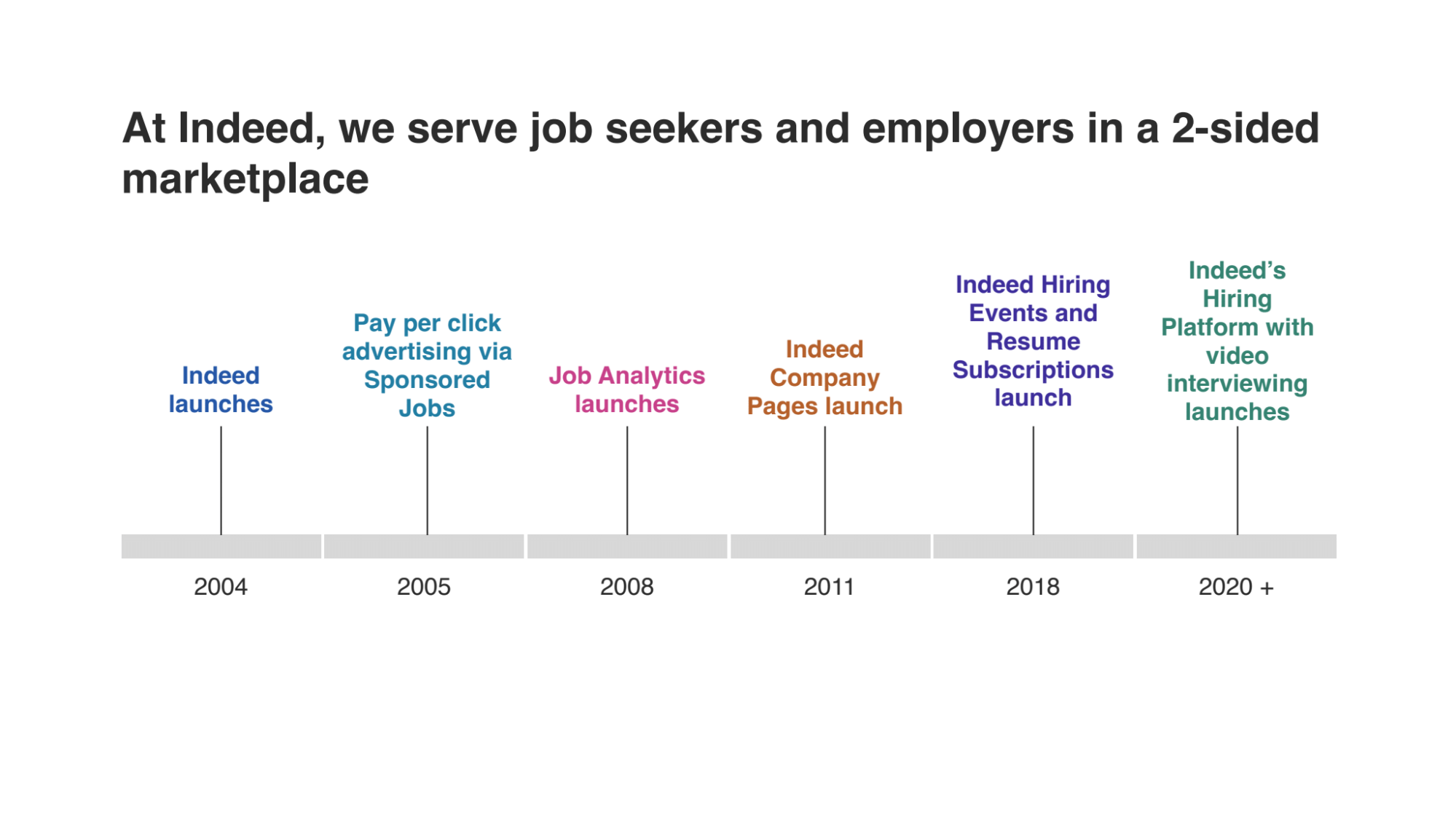
Throughout our journey, we have introduced various products and features. In 2011, we launched our company pages, similar to Glassdoor (our sister company), where employers can showcase their brand and working environment. In 2018, we introduced hiring events with resume subscriptions, enabling recruiters to proactively reach out to job seekers.
Emphasis on automation: Streamlining the hiring process
More recently, we have placed a strong emphasis on automation, making it easier for employers to hire and connect with job seekers. We have remained true to our original vision, keeping our platform focused solely on jobs and ensuring job seekers always come first.
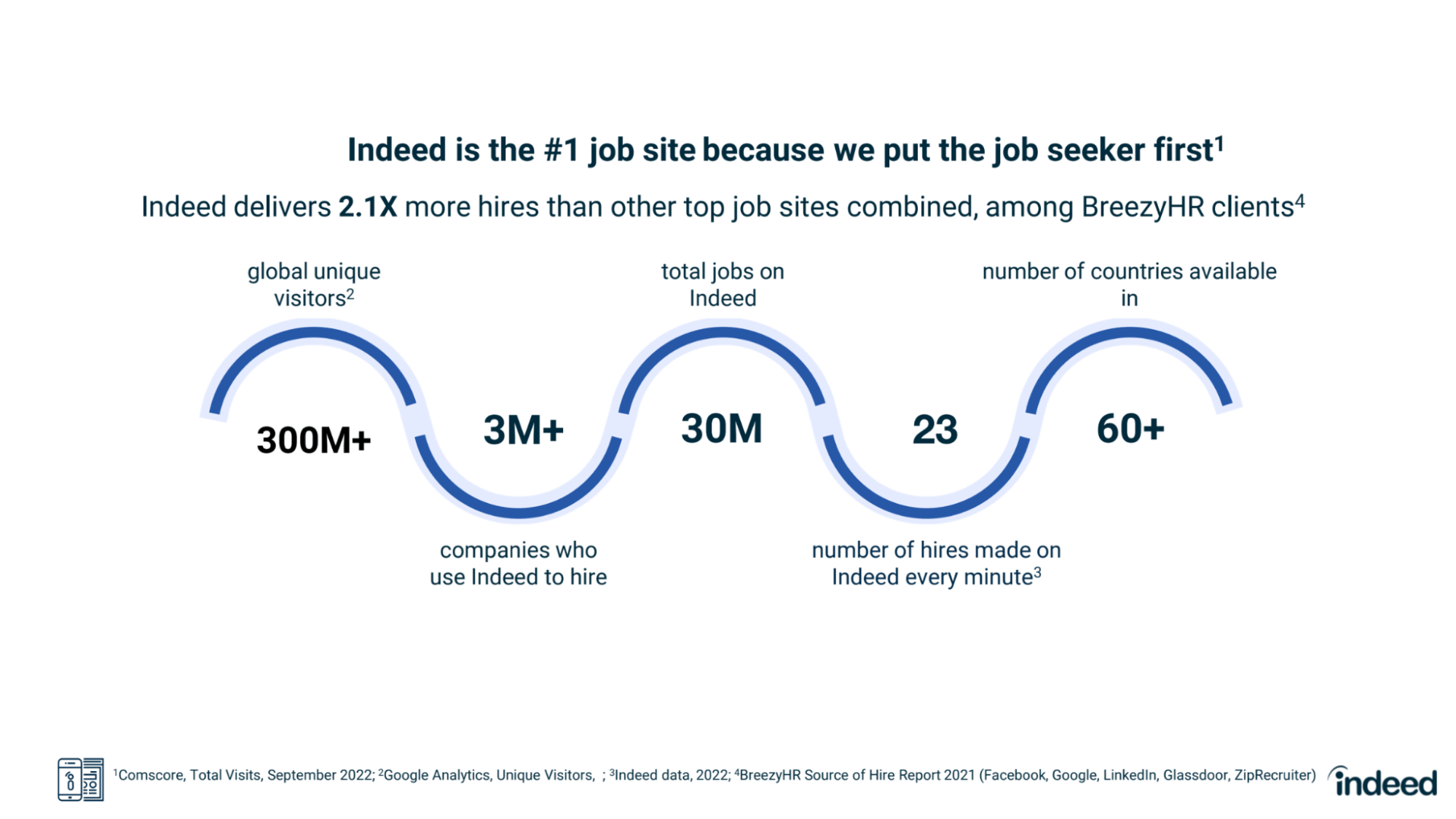
Our efforts have paid off, as Indeed has become the number-one job site in the world. Every minute, an astounding 23 hires are made on Indeed.
These numbers demonstrate the impact we have in the job market.
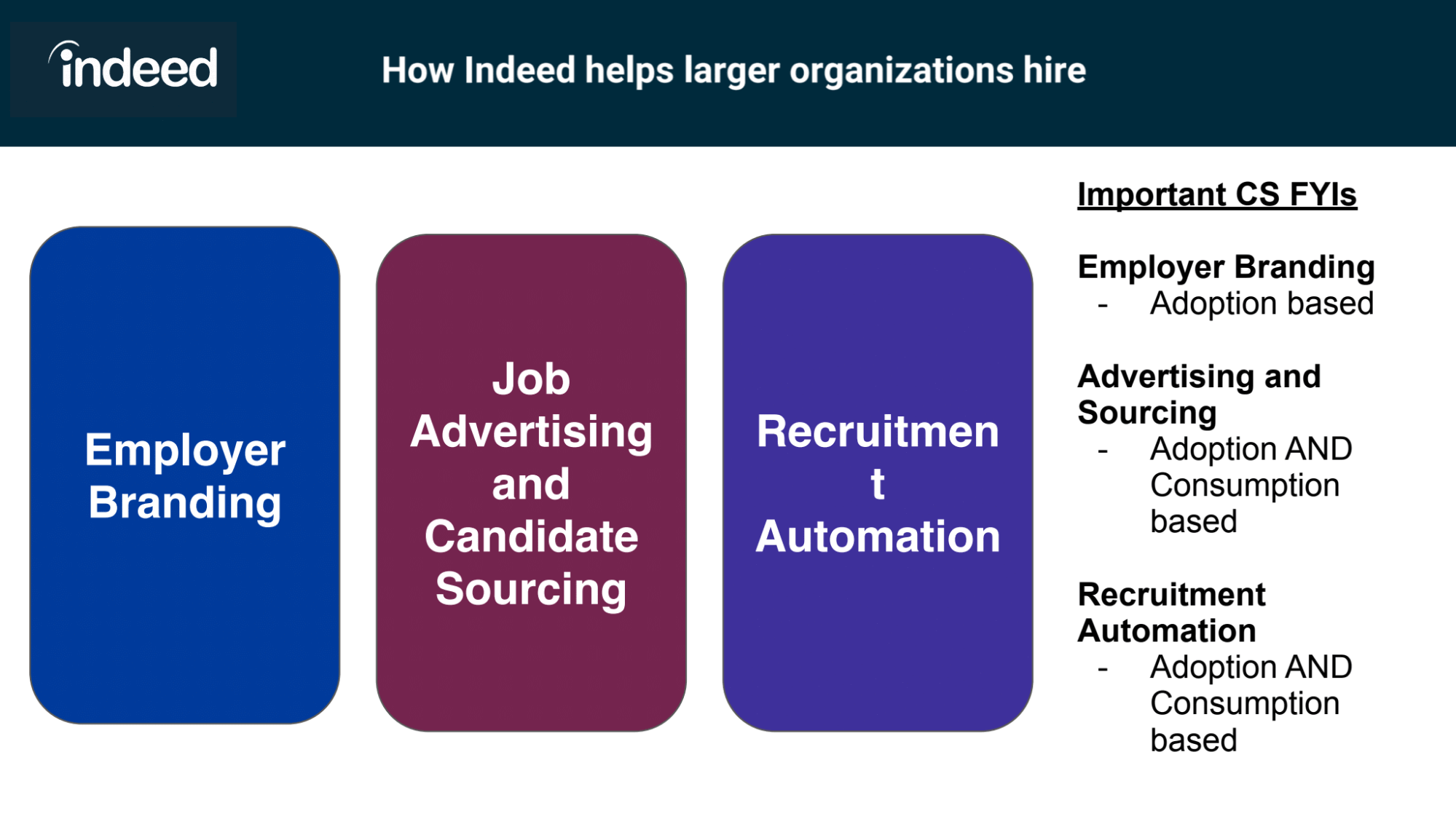
Complex client challenge
Over the past two years, I have been focused on tackling the challenge of serving complex clients at Indeed. Working for a large company like ours, with thousands of customer success representatives, has taught me that complex customers exist in every organization, regardless of its size.
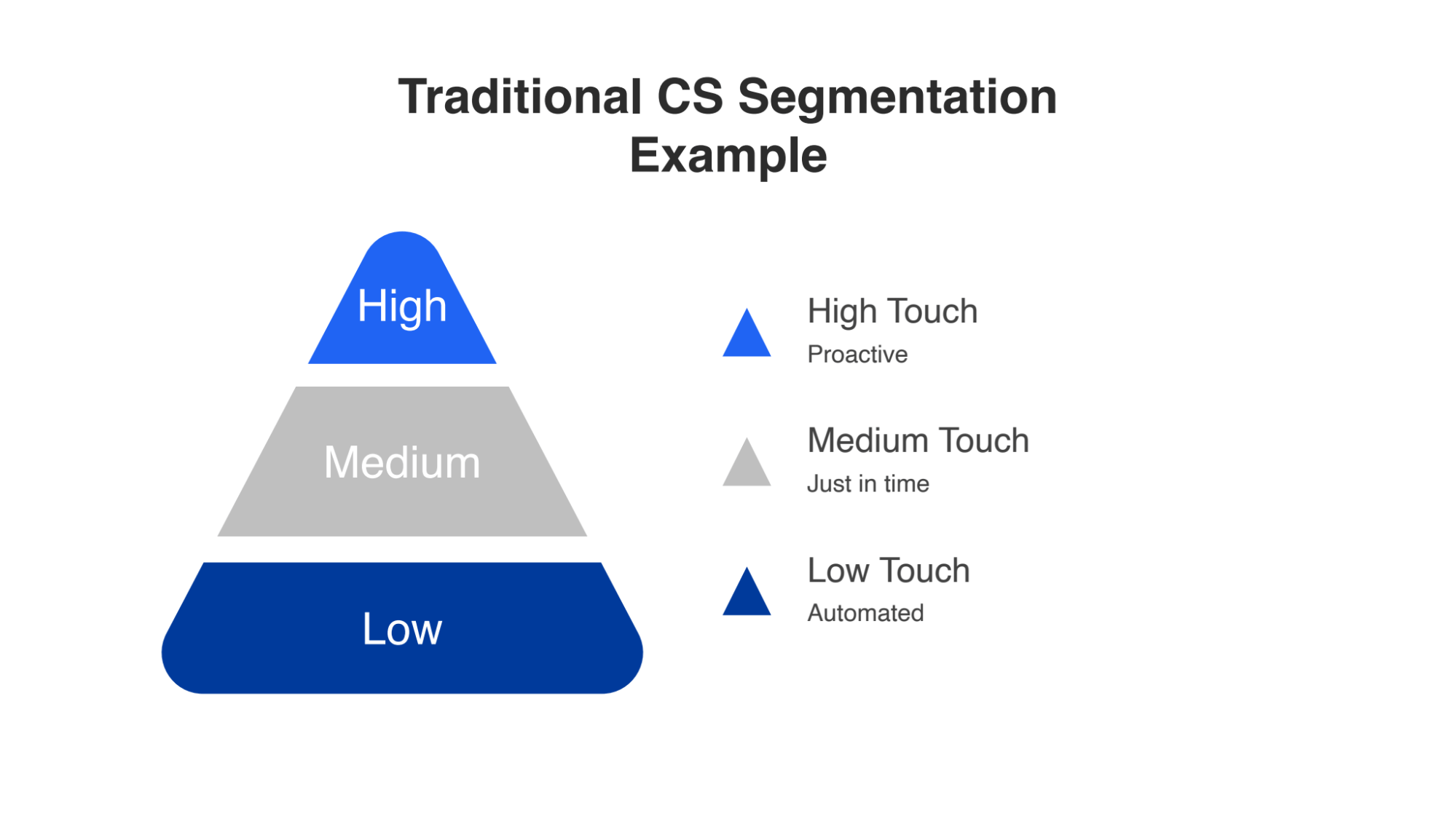
Many of you may be familiar with the traditional customer segmentation model represented by this triangle. While this model is useful, it often fails to capture the complexity of customer needs.
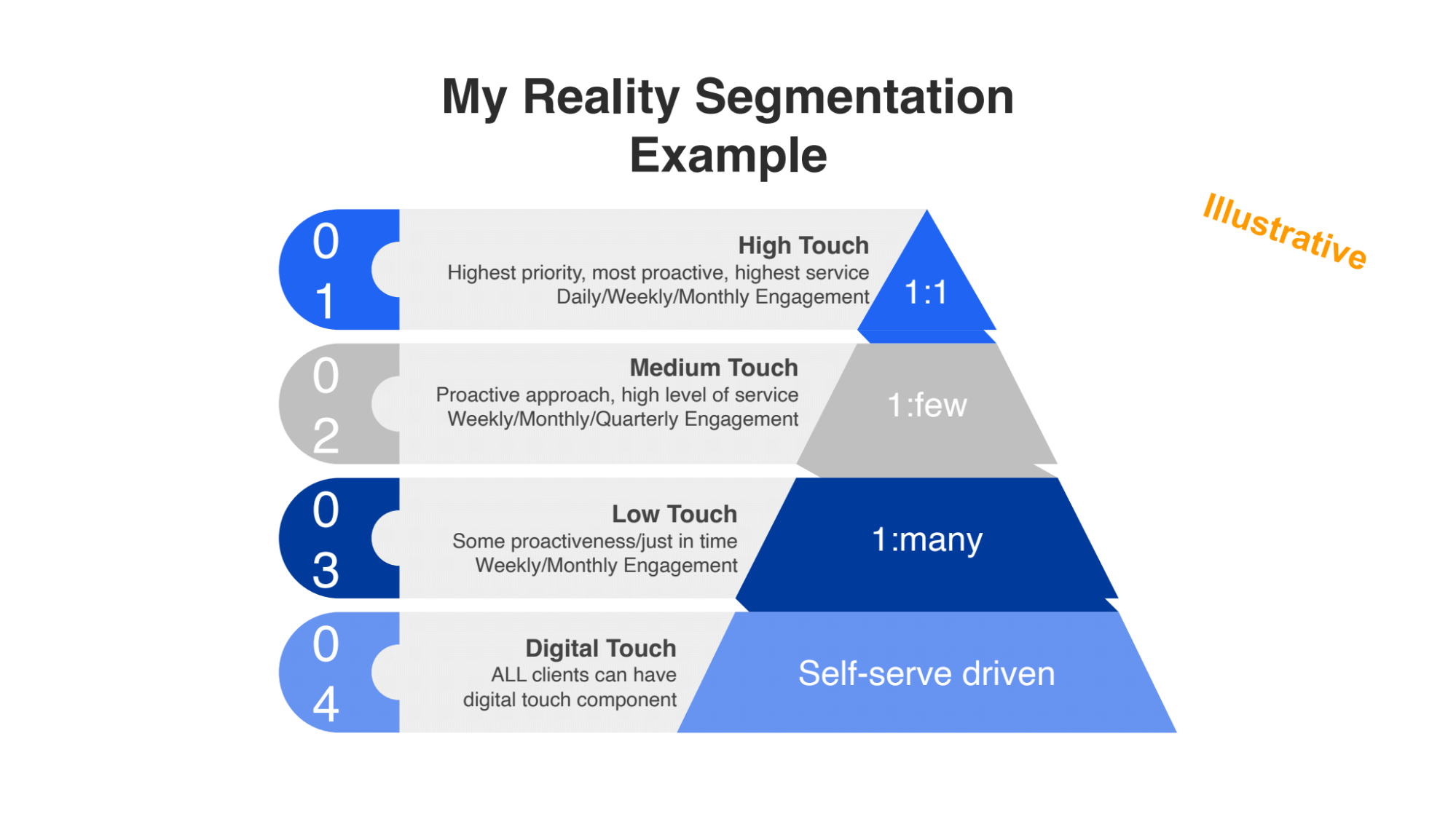
At Indeed, we have developed a more realistic segmentation model. One key difference is the emphasis we place on digital touchpoints for all our customers, regardless of their size or complexity. We recognize that there is a time and place for self-service, but we also prioritize high-touch engagement for our most important customers.
Our high-touch customers receive proactive and personalized support, with regular communication and dedicated service. As we move down the pyramid, the level of engagement gradually decreases. However, what happens when one client fits into multiple segments?
Addressing complexity: A hypothetical customer case study
To demonstrate the challenges of serving complex clients, let's consider a hypothetical customer called Capital Incorporated. They are a multinational technology company with divisions in e-commerce, cloud computing, online advertising, and logistics.
This Fortune 10 company operates across various sectors with diverse hiring needs. Each division utilizes Indeed differently, leveraging our technology in unique ways.
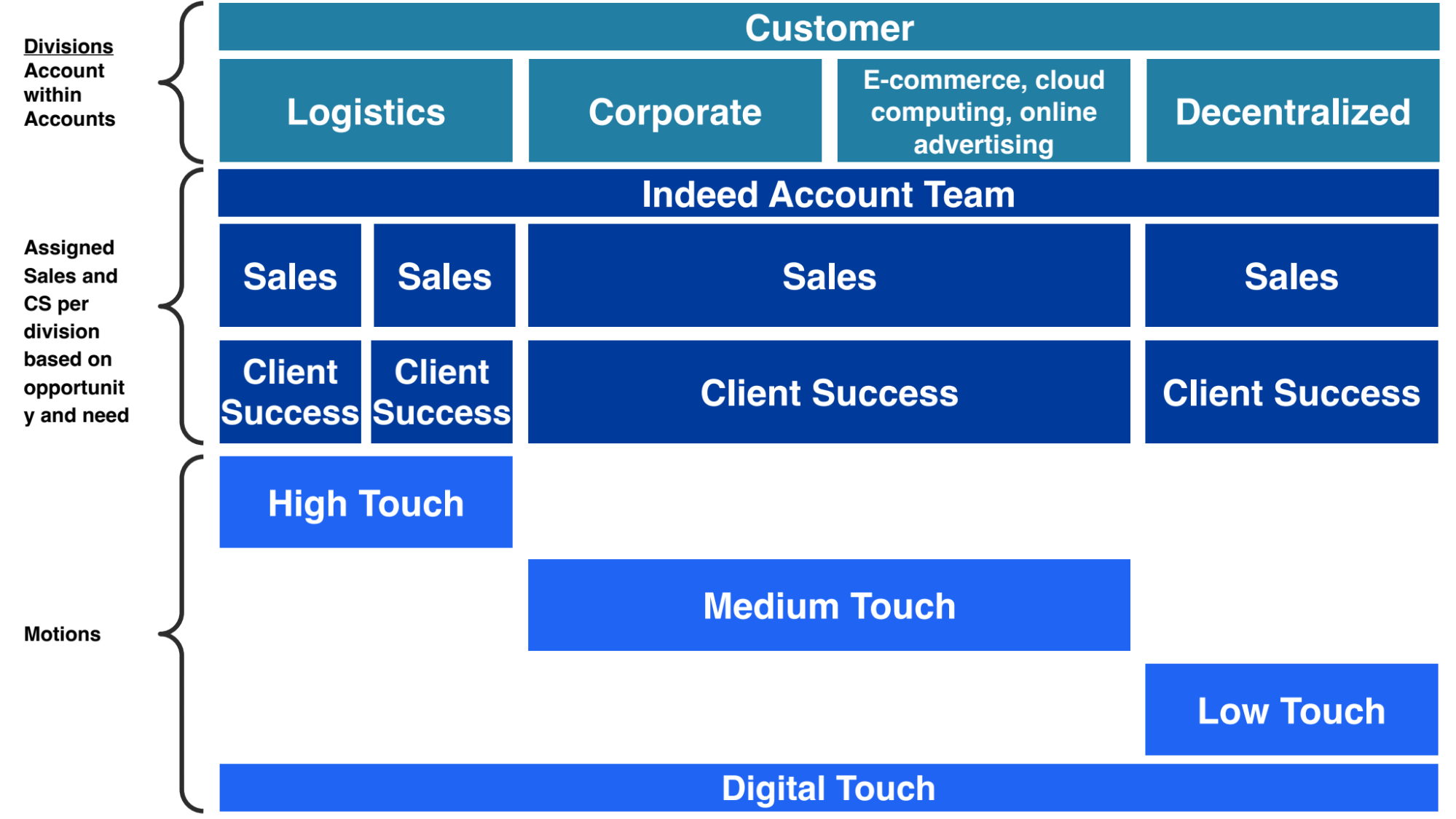
For example, the logistics division hires millions of warehouse workers annually, relying heavily on Indeed for its hiring strategy, advertising campaigns, and operational efficiency.
On the other hand, the corporate division focuses on hiring professionals with different profiles, requiring distinct tools and strategies. Additionally, the decentralized low-touch division, comprising drivers scattered across the company, relies on just-in-time engagements and digital touchpoints.
At Indeed, we have realized that complex clients demand tailored account teams to effectively address their unique needs. For large and complex clients, we treat them as accounts within accounts, ensuring that we allocate the necessary sales and CS resources to each division based on their opportunities and requirements.
Unlike traditional handoff conversations, we have developed a continuous engagement model at Indeed. Our clients are constantly active on our platform, with hiring needs that fluctuate throughout the year. Consequently, we strive to deliver the right people at the right time to serve them effectively.
Returning to the segmentation model means assigning dedicated sales and CS representatives to the logistics division due to its significant workload and importance.
For the corporate and e-commerce divisions, we can combine resources into a medium-touch approach with one sales and CS representative. Lastly, the decentralized low-touch division requires digital touchpoints and just-in-time engagement.
It’s important to acknowledge that working in a large company like Indeed provides access to abundant resources. However, I recognize that not every organization can readily allocate additional staff. Hence, finding the right balance and optimizing available resources is crucial to successfully serve complex clients.
Roles and responsibilities and risk mitigation
At Indeed, we began addressing the challenge of complex customers by focusing on prioritization. We honed in on the most important divisions first, emphasizing digital touchpoints at the bottom.
This leads me to my second learning: roles and responsibilities and mitigating risk are crucial. Ensuring that the right people are doing the right things at the right time builds trust and credibility over time.
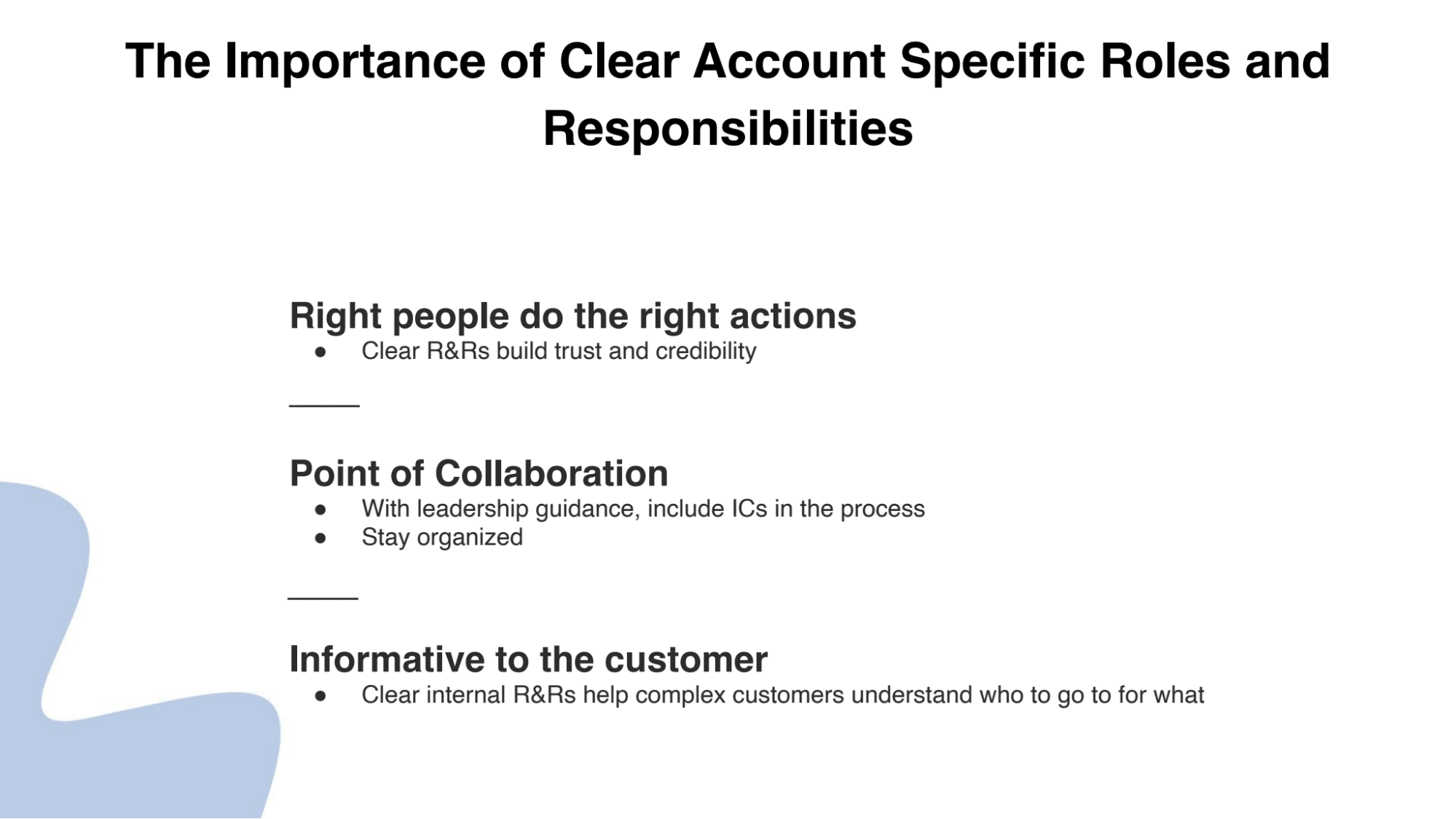
For instance, when we establish clear roles and responsibilities and communicate them effectively to our sales counterparts, we empower them to relinquish some ownership and collaborate more effectively. It's a practice that fosters alignment within our team.
Our experienced and high-performing representatives are involved in this process, as they have valuable insights to contribute. Documentation plays a vital role in staying organized, ensuring that everyone understands their tasks and responsibilities within the account.
Moreover, we understand that complex teams can be confusing for clients. To address this, we provide our clients with external-facing versions of our roles and responsibilities framework. This way, they know exactly who to approach for specific matters and when.
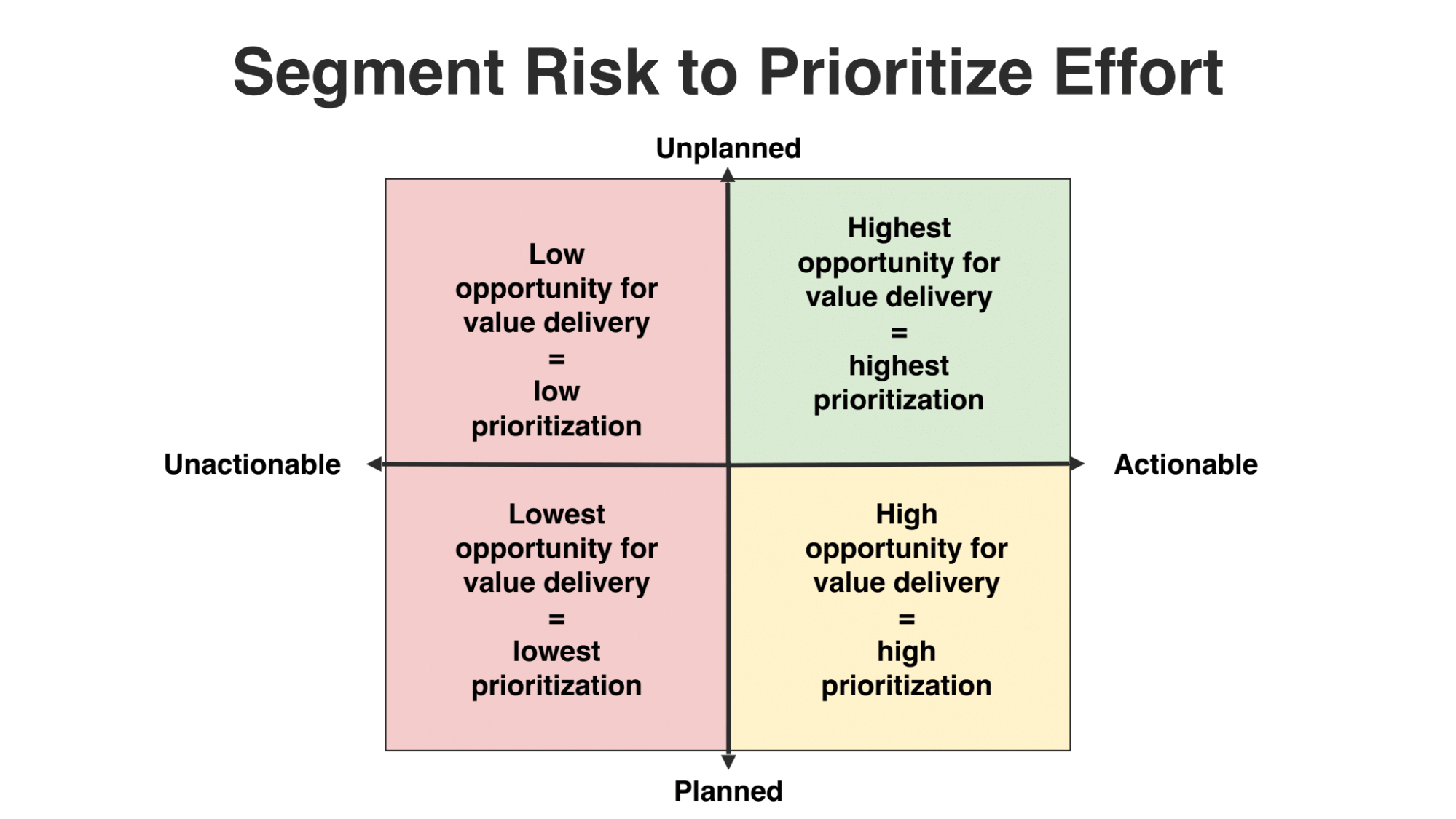
By segmenting and prioritizing our efforts, we leverage success plans. We categorize risks into planned and unplanned, as well as actionable and actual. This unique approach at Indeed stems from the cyclical nature of hiring and the economy. We have learned that focusing on unplanned and actionable risks allows us to deliver the most value to our clients.
Engaging with your product and go-to-market teams
When it comes to customer success, we recognize that we have the ability to address challenges head-on. Unplanned events can provide us with an opportunity to step in and offer assistance, leveraging our expertise to optimize return on investment and provide valuable services.
However, we also understand the importance of identifying risks that are beyond our control. For instance, if a major customer decides to lay off half of their workforce, a situation unrelated to our services, we don't want our teams to allocate excessive time and resources there. To tackle this, we have implemented a framework that helps us prioritize our efforts and focus on areas where we can make the most impact.
Another key aspect of ensuring customer success is establishing strong relationships between our internal product and go-to-market teams. Have you ever found yourself on a client call only to discover that your client is discussing a product or feature change that you were not aware of? It's a relatable experience highlighting the need for better communication and collaboration with these teams.
By cultivating direct relationships, we can establish a feedback loop that fosters urgency and drives meaningful conversations. It's a two-way street, with our teams providing valuable feedback to the product and go-to-market teams while receiving insights and updates on upcoming changes.
To effectively engage with these teams, we have introduced advanced notice processes and escalation paths. Regular touchpoints and meetings within the organization ensure that we stay informed about upcoming developments. In fact, we have recently hired an operations manager to assist with these efforts.
Weekly product updates provide us with early access to information, allowing our team to analyze potential impacts and engage in strategic discussions. This proactive approach enables us to have more fruitful conversations rather than reacting to product releases without prior knowledge.
One area where our customer success teams have excelled is quantifying the impact of our services.
Their ability to build business cases and articulate the value of adding or removing features has been invaluable. This proficiency helps us effectively communicate with internal teams, addressing their primary concerns about revenue impact and the necessity of requested changes.
It strengthens the trust and credibility we have built, showing that we have thoroughly considered their needs and are not simply providing vague feedback.
Navigating complex challenges: The power of iteration

Lastly, we emphasize the importance of iteration when working with complex customers. Complex challenges require time and ongoing improvement. We often remind our teams that progress from zero to 100 cannot be achieved overnight. Instead, we focus on incremental steps and celebrate milestones along the way. This approach tells a story of continuous improvement and highlights the value we have already delivered.
While we have a clear vision of the desired outcomes, we remain adaptable to their evolving business goals and challenges. We understand that the world is constantly changing, and our ability to iterate ensures that we stay aligned with our customers' needs.
As we navigate the ever-changing landscape of customer success, it's crucial to acknowledge that our initial Northstar may evolve over time. We understand that circumstances can shift, and we remain flexible in our approach, allowing us to pivot when necessary.
Furthermore, we embrace the philosophy that progress is better than perfection. In our team culture, we foster a mindset of continuous learning and adaptation. We actively challenge the status quo, seeking opportunities for growth and improvement.
Rather than striving for perfection, we focus on making progress, learning from our experiences, and swiftly moving forward. It's essential to avoid overwhelming ourselves by taking on too many projects at once. Instead, we take the time to reflect on what we've learned, incorporate those insights into our approach, and then shift our focus to the next task at hand.
Four essential tips to drive value for complex customers
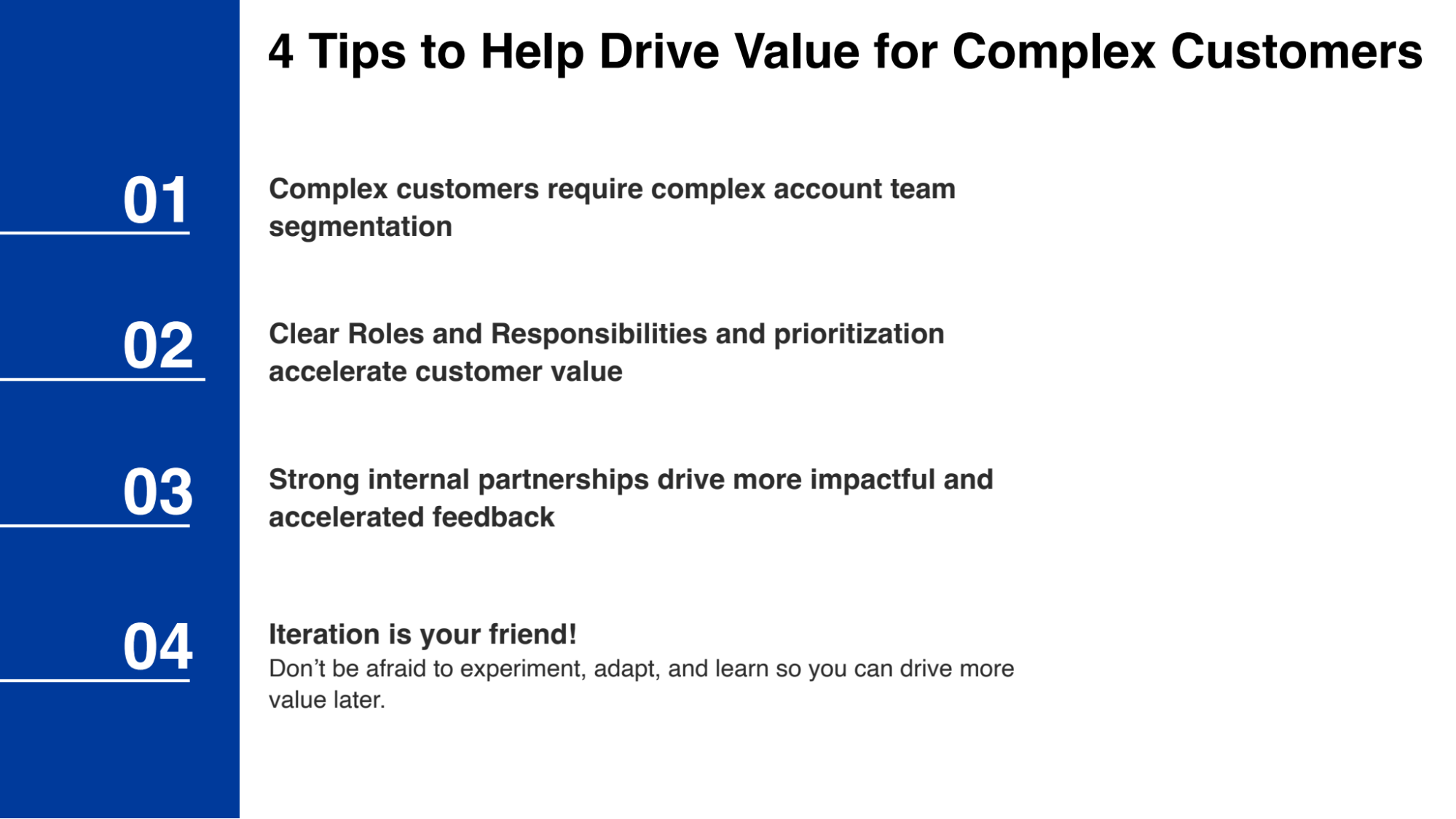
To summarize, here are the four essential tips to drive value for complex customers that we've explored:
1. Complex customers require complex account teams
Recognize the need for specialized teams that can effectively cater to the unique demands of these customers. Assigning clear roles and responsibilities within these teams is essential for delivering targeted support.
2. Prioritize and establish clear roles
Clearly define roles and responsibilities, ensuring that everyone understands their specific areas of focus. This clarity enables smoother collaboration and efficient use of resources.
3. Foster strong partnerships with product and go-to-market teams
Collaborating closely with internal teams responsible for product development and go-to-market strategies allows us to provide timely feedback, align our efforts, and drive progress.
4. Embrace iteration and learning
Don't shy away from experimentation and continuous improvement. Embrace an iterative approach, learning from each experience, and incorporating those learnings into future endeavors. This mindset allows us to deliver increasing value as we adapt and evolve.
By implementing these strategies, we aim to enhance customer success and deliver exceptional value to our complex customers. Consider how you can apply these insights within your own organizations.
Embrace the idea of adaptability, prioritize clear roles and responsibilities, foster strong partnerships, and embrace the power of iteration. These principles will help guide you toward driving meaningful value and achieving success with your most complex customers.

Q&A
Q: How do you effectively cross-sell if your customer success or sales teams are separated by unique personas or divisions in org?
A: At Indeed, we have a unique approach to sales and account management. Our sales team and customer success teams work hand in hand to ensure a seamless customer experience. While our sales team primarily handles the initial selling conversations, our CS teams play a crucial role in identifying upsell and cross-sell opportunities.
When it comes to segmentation, we already have divisions in place, which naturally present opportunities within each segment. Rather than focusing on upselling or cross-selling across different divisions, our approach is more like a cross-sell/upsell within the same division. Let me explain further.
Imagine working with a large company where you have a designated point of contact on the East Coast. While the sales team may initially establish the relationship, the CS team comes in to nurture it.
Now, instead of trying to cross-sell to other divisions, we leverage the existing relationships and expand our reach within that specific division. For example, we would explore upselling and cross-selling opportunities to counterparts on the West Coast within the same division. This approach allows us to maximize the potential within each vertical.
By adopting this strategy, we can effectively tap into the vast opportunities within complex organizations. Rather than spreading our efforts thin across various divisions, we focus on building strong relationships and expanding within each segment. This approach ensures that we are delivering value to the specific needs of each division, while also optimizing our sales efforts.

Q: How do you make the decision to split an account down to the division level for a source location? And what are the key considerations there?
A: When it comes to expanding our team and making a case for additional resources, it all boils down to the opportunity at hand. At Indeed, we have been successful in securing the business case for hiring more people by taking a step back and thoroughly understanding the daily responsibilities of our current team. This involved conducting surveys, shadowing team members, and diligently taking notes.
By gathering this comprehensive information, we were able to present a clear picture to our leadership. We highlighted where we were investing most of our time and the corresponding revenue generated from our work with major billion-dollar companies. Recognizing the untapped potential and available budget within these accounts, we proposed a more segmented approach.
With a deeper understanding of the specific needs and priorities of each account, we could allocate resources accordingly. Over time, this approach has proven successful in driving growth and delivering value.
To make informed decisions regarding complex accounts, it's crucial to clearly understand what your teams are working on.
By immersing yourself in the details and being in the weeds, you gain valuable insights that inform your decision-making process. This level of understanding enables you to advocate for the necessary resources and make strategic choices that propel your team forward.

Q: Do clients know that they are considered a digital-touch customer?
A: When it comes to internal segmentation, we don't explicitly communicate these segments to our clients. However, the digital touch aspect is crucial in our approach.
Let's take the logistics example, for instance. Even though the customer may not be aware of the specific segmentation, they will experience various forms of digital touchpoints. These could include marketing-generated emails providing campaign performance updates and other relevant information.
While this topic may not arise frequently, it's essential for us to ensure that our clients understand they have dedicated representatives at Indeed who are ready to assist them in maximizing their hiring potential. This requires us to approach the situation with empathy and a genuine desire to help them achieve their goals.
By maintaining a strong focus on digital touch and providing exceptional support, we can effectively navigate the complexities of client segmentation. Our commitment to understanding their unique needs and offering personalized assistance sets us apart and reinforces our dedication to helping them succeed.
In conclusion, while internal segmentation is not explicitly communicated to our clients, the digital touch component plays a significant role in our interactions. We strive to provide top-notch support and make our clients feel supported and empowered to achieve their hiring objectives. By demonstrating empathy and leveraging our expertise, we build strong relationships that drive mutual success.

Learn today. Lead tomorrow.
If you enjoyed reading Edward's insights, then why not browse our catalog of customer success courses? Whether you'd like to master retention, hone your leadership skills, or perhaps just brush up on your core CS skills, we have something for everyone, at any stage in their career.



 Follow us on LinkedIn
Follow us on LinkedIn




